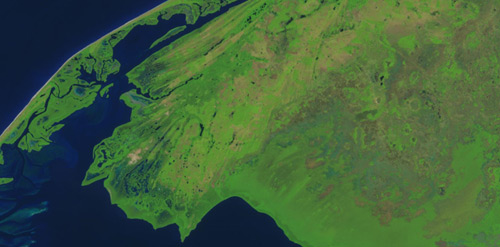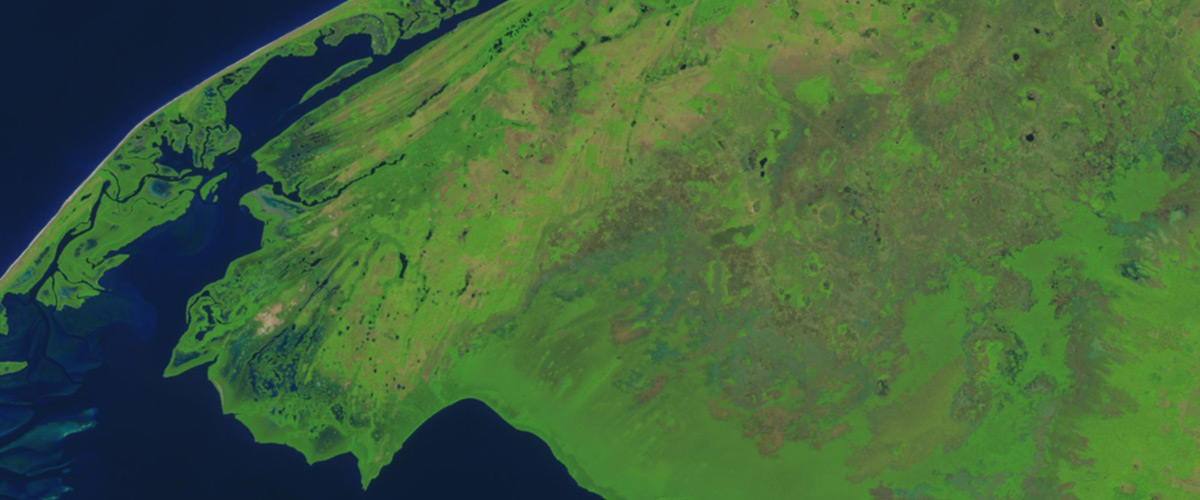PPSP Project Overview
The Punta de Piedra/Noham mangrove conservation and restoration project consists of 15,040 hectares located in the Sabancuy Estuary in the state of Campeche, Mexico. Mangrove species within the project area include Rhizophora mangle, Avicennia germinans, Laguncularia racemosa and Conocarpus erectus. The project area is part of the southwest Campeche flood plain and the estuary communicates with the northeast portion of Laguna de Términos complex. The hydrology consists of numerous flooded lowlands and high soluble salts content, as well as lagoons and wetlands. Mangrove degradation is a problem due to illegal logging and burning to make way for pasture lands. Without the project and planned activities, the mangroves will continue to be deforested.
The project’s conservation and restoration activities will be conducted entirely by local community members and will be trained by an experienced local cooperative managed by women. The project leadership will include local community members as well as financial benefit streams will flow directly to more than 500 local community families. Local community participation in the restoration and reforestation of 2,200 hectares of degraded mangrove area will provide incentive for the locals to preserve and protect the mangroves. In addition to the direct employment, the environmental services that will be provided by the ecosystem once recovered will include quality of habitat for fish and birds, improved water quality, as well as sequestration of more than 5.790 million tCO2e over the life of the project. From the 12,800 Ha of pristine mangroves, another 3.850 million tCO2e in avoided emissions will be prevented due to the conservation activities over the life of the project.
Relevant ecosystem services provided beyond carbon include ecotourism, local fishing for food, commercial fishing, and production of honey. The area is biologically rich, where 15 vegetative associations, with a total of 374 species are found. Threatened floral species found the area includes the Bletia purpurea, Bravaisia integerrima, B. tublifora. Endangered flora species found include the orchid Habenaria bractescens. Fauna estimates suggest that there are at least 1,468 species, both terrestrial and aquatic. Studies have found that the largest populations of the endangered jaguars (Panthera onca) are found in the Sabancuy area and around Laguna de Terminos, as well as the American crocodile (Cocodrylus acutus) and Morelet’s crocodile (C. Moreletii). The hawksbill turtle (Eretmochelys imbricata), green turtle (Chelonia midas) and Kemp’s Ridley turtle (Lepidochelys kempi) are under special protection. Lastly, preserving urban wetlands in good condition, contribute to making cities and towns safer from the manifestations of climate change.
Project Area Highlights:
- 15,040 Ha Mangrove
- 12,840 Ha Conservation
- 2,200 Ha Restoration
- 3,850,000 tCO2 Avoided
- 5,790,000 tCO2 Sequestered

KML File available for download
Project Supplemental Information
(Click to start the presentation)
Sustainable Development Goals (SDGs) and Impacts
For a full list and explanation of each SDG, click here
SDG 1:![]() No Poverty
No Poverty
Blue Carbon Projects employs local community members to work on project areas and perfrom conservation and restoration activities.
SDG 2:![]() Zero Hunger
Zero Hunger
Restoring mangroves will create productive ecosystems, providing sufficient and nutritious food to local communities all year round.
SDG 5:![]() Gender Equality
Gender Equality
The Cooperatives we work with is 200% managed by women, with a amority-female work force. At the height of it’s activities, our cooperative has employed more than 800 community members.
SDG 8:![]() Decent Work and Economic Growth
Decent Work and Economic Growth
Mangrove restoration activities can create local income opportunities, providing full and productive employment for community members. The mangroves also provide an additional source of economic growth via potentially increased tourism that creates jobs and promotes local culture and products.
SDG 11:![]() Sustainable Cities and Communities
Sustainable Cities and Communities
Mangroves help reduce the adverse effects of a natural disasters, like flooding, storm surges and soil erosion, ensuring the continued safe survival of populated areas.
SDG 13:![]() Climate Action
Climate Action
Mangroves are highly effective in carbon sequestration. Mangroves allocate proportionally more carbon below-ground and have higher below- to above-ground carbon mass ratios than terrestrial trees. Most mangrove carbon is stored as large pools in soil and dead roots.
SDG 14:![]() Life Below Water
Life Below Water
Mangroves restoration will protect marine and coastal ecosystems, avoiding adverse impacts, and achieving healthy and productive oceans. Mangroves act as nurseries for many fish species, crustaceans, and mollusks. The project ensures the growth of their habitat and protects these biologically complex ecosystems.
SDG 15:![]() Life On Land
Life On Land
Through planting mangroves on degraded lands, the soil organic contents and minerals will be increased, and vegetation cover will improve soil conditions, regaining healthy ecosystems which are ideal habitats for a variety of plant and animal species.
Project Impacts and Outcomes

Implementation Timeline
To Be Determined
Related Imagery and Resources
Ongoing Field Worklog Notes
B1-2019 Ground-truth and site visit
Lorem ipsum dolor sit amet lectus quisque taciti ultrices ornare nec mauris tellus nullam platea ante consectetur placerat nam malesuada erat iaculis sapien magna morbi tempus tortor volutpat fringilla pretium porta hac libero pulvinar eleifend ex feugiat pharetra laoreet eu tristique luctus maecenas fusce volutpat finibus vestibulum eros viverra amet

